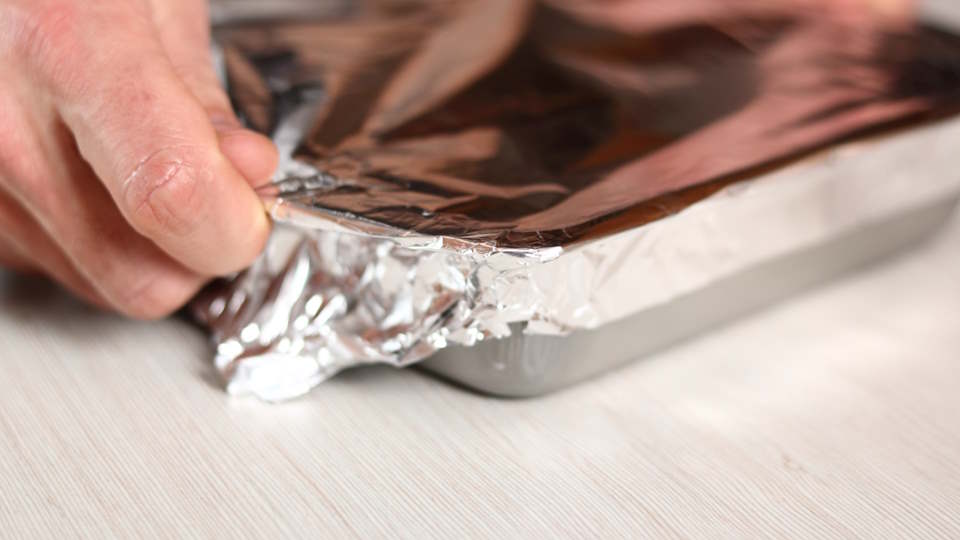As we rely more on microwaves to quickly heat and cook our food, we often wonder if certain materials are safe to use. One such material is aluminum foil. Can you put aluminum foil in a microwave? Is it safe to heat food in aluminum foil in a microwave? These are common questions that we may have while using our microwaves. We will explore the answers to these questions and more to help you use your microwave safely and effectively.
Introduction
Aluminum foil is a common kitchen item used for cooking and food storage. It is lightweight, durable, and non-toxic, which makes it an excellent choice for wrapping and covering food. However, many people are unsure about whether aluminum foil is safe to use in the microwave or not. So, can you microwave aluminum foil?
The answer is no. It is not safe to microwave aluminum foil because it can cause a fire. When you microwave aluminum foil, it creates sparks that can ignite nearby flammable materials, such as paper or plastic. Additionally, the foil can cause arcing, which can damage the microwave’s electronics and cause it to stop working.
If you want to heat food in the microwave, it is best to transfer it to a microwave-safe container that is designed for the job. Look for containers that are labeled as microwave-safe or have the microwave symbol on them. You can also use microwave-safe plastic wrap or wax paper to cover your food.
- Here are some other things that you should not put in the microwave:
- Metals, such as aluminum foil or metal cookware
- Plastic containers that are not labeled as microwave-safe
- Styrofoam containers
- Disposable plastic containers or plates
By being aware of what should and should not be put in the microwave, you can prevent accidents and keep your family safe. Remember to always read labels and follow manufacturer’s instructions when using any kitchen products.
How Do You Heat Food in Aluminum Foil in the Microwave?
Aluminum foil is one of the most commonly used food wrappers in the world. It is great for packaging leftovers, cooking food in the oven and even for covering dishes that are microwaved. However, while it is safe to use aluminum foil in the oven, it is important to follow some precautions when using it in the microwave.
First and foremost, make sure that the aluminum foil is not crumpled or tightly creased. This can cause the foil to heat up too quickly and create sparks or small fires inside the microwave. It is also a good idea to use a piece of foil that is slightly larger than the dish you are covering. This will allow for some space around the edges and prevent the foil from touching the sides of the microwave.
- Step 1: Cut the aluminum foil
Cut a piece of aluminum foil that is slightly larger than the dish you want to cover. Make sure there is enough foil to fold over and seal the edges of the dish.
- Step 2: Place the food on the foil
Place the food you want to heat or cook on the center of the foil. Make sure that any edges or corners of the food are not touching the foil.
- Step 3: Fold the foil over the food
Bring the edges of the foil up and over the food. Press the edges together to create a seal. Make sure that there are no gaps or holes in the foil.
| Do: | Do Not: |
|---|---|
| -Use a piece of foil that is slightly larger than the dish you are covering | -Use crumpled or tightly creased foil |
| -Make sure there is enough space around the edges of the foil to prevent it from touching the sides of the microwave | -Let the foil touch the sides of the microwave |
| -Fold the foil over the food and press the edges together to create a seal | -Leave gaps or holes in the foil |
While it is safe to use aluminum foil in the microwave, it is important to take the necessary precautions to avoid any accidents. By following these simple steps, you can safely and effectively heat or cook food in aluminum foil without any problems.
Why Is Foil Safe in Oven and Not Microwave?
Many people are familiar with using aluminum foil in the oven – it is a staple for roasting and baking. However, few people know that using aluminum foil in the microwave can be dangerous. So how come aluminum foil is safe in the oven but not in the microwave?
Firstly, it is important to understand how microwaves work. Microwaves use radiation to heat food, rather than convection like ovens. This radiation causes the metal in aluminum foil to spark and ignite, which can lead to a fire. This is why aluminum foil should never be used in the microwave.
- However, when using aluminum foil in the oven, the metal is not exposed to radiation. Instead, the foil simply reflects the heat from the oven walls and distributes it evenly around the food. This helps the food cook more evenly, and also prevents it from sticking to the baking dish.
Another reason aluminum foil is safe in the oven is due to the lower power output. Ovens have a lower wattage than microwaves, which means they heat food more gradually and less intensely. This reduces the likelihood of a fire starting when using aluminum foil.
| Microwave: | Oven: |
|---|---|
| Uses radiation | Uses convection |
| Higher wattage | Lower wattage |
| Can cause a fire | Less likely to cause a fire |
What Happens if You Accidentally Microwave Aluminum?
It’s common knowledge that you should not put metal in a microwave because it can cause a fire or damage your appliance. However, accidents happen and sometimes we might forget to check if there’s aluminum foil in our food before heating it up. So, what happens if you accidentally microwave aluminum?
First of all, let’s clarify what we mean by aluminum. We’re referring to aluminum foil, containers, or utensils. These items have thin layers of metal that can create a spark when exposed to the electromagnetic waves of the microwave.
- If you microwave a small piece of aluminum foil, it’s likely that nothing will happen. However, if the foil is crumpled or folded, it can create a spark and cause a fire. So, be careful when reheating your leftovers!
- If you microwave a container or utensil made of aluminum, it will heat up and can potentially damage your microwave. The metal can also transfer heat to the food unevenly, leading to hot spots and cold spots.
In addition to the risk of fire and damage to your appliance, microwaving aluminum can also be a health hazard. When aluminum is heated, it can leach into your food and contaminate it. High levels of aluminum in the body have been linked to health problems such as Alzheimer’s disease and kidney damage.
What Should Not Be Put in Microwave?
In today’s fast-paced world, microwave is a highly convenient appliance that helps us heat up and cook meals quickly. However, not everything is microwave-safe. Putting certain items in the microwave can lead to unwanted consequences such as sparking, explosion, or even fire. Here are some materials that you should avoid putting in the microwave:
- Aluminum foil: Unlike other metals that reflect microwaves, aluminum foil reflects them poorly. This results in overheating and potentially starting a fire.
- Styrofoam: Styrofoam containers can release toxic chemicals when heated, posing a health hazard. Moreover, they easily melt or warp, making a mess in your microwave.
- Plastic containers: Some plastic containers are labeled “microwave-safe,” but many types of plastic contain chemicals that can leach into your food when heated. Avoid putting plastic wraps, bags, and containers that are not specifically labeled as microwave-safe.
- Paper bags: Paper bags can ignite in the microwave due to the high temperature and lack of moisture. Popcorn bags may contain a metallic lining that can cause a fire or electric spark in the microwave.
It’s important to remember that any metal, including utensils, should not be put in the microwave. Even if they do not start a fire, they can cause hot spots that can damage or crack your microwave. Additionally, some foods like hard-boiled eggs, grapes, and hot peppers can explode when heated in the microwave.
The rule of thumb is to avoid putting anything in the microwave that is not expressly labeled as safe. If you have doubts about a particular item, it’s better to err on the side of caution and use another cooking method. By following these guidelines, you can ensure a safe and hassle-free experience with your microwave.
What Is the Safest Thing to Cover Food in a Microwave?
When it comes to reheating food in a microwave, many people cover their food with a lid or wrapping to prevent splattering. However, not all materials are safe to use in a microwave. Some materials can even cause fires or release harmful chemicals. So, what is the safest thing to cover food in a microwave?
The safest material to use as a cover for food in a microwave is microwave-safe plastic wrap or glass containers with lids. These materials are specially designed to withstand the microwave radiation without melting or releasing harmful chemicals into the food.
- Plastic Wrap: Make sure the plastic wrap you use is labeled as microwave-safe. Also, keep it a few inches away from the food to prevent contact.
- Glass Containers: Use glass containers with microwave-safe lids. Avoid using glass containers with metal parts, as they can cause sparking inside the microwave.
Other safe options for covering food in a microwave include microwave-safe paper towels or microwave-safe plates. However, it’s important to make sure the material you use is specifically labeled as safe for use in microwaves.
| Safe to Use in Microwave | Not Safe to Use in Microwave |
|---|---|
| Microwave-safe plastic wrap | Regular plastic wrap |
| Glass containers with microwave-safe lids | Glass containers with metal parts |
| Microwave-safe plates | Plates with metallic or gold/silver trim |
In summary, the safest thing to cover food in a microwave is microwave-safe plastic wrap or glass containers with microwave-safe lids. Avoid using regular plastic wrap, glass containers with metal parts, or plates with metallic or gold/silver trim. Always check the label or packaging of the material to make sure it’s safe for use in a microwave.



